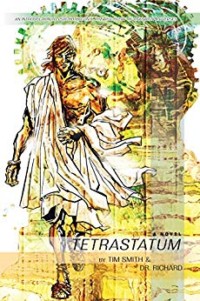Title: Tetrastatum
Authors: Dr. Richard, Tim Smith
Publisher: Epigraph Books
ISBN: 978-1-948796-68-2
Genre: Science Fiction
Pages: 284
Reviewed by: Carl Conrad
Pacific Book Review
 In a novel that verbally recreates the physical settings of the rooms, procedures, meetings, and equipment of a science lab as realistically as anything you’ll probably ever read, Tetrastatum, by Tim Smith and Dr. Richard is a science fiction novel based as completely on science fact as one could get in describing real space-time travel if it were to exist.
In a novel that verbally recreates the physical settings of the rooms, procedures, meetings, and equipment of a science lab as realistically as anything you’ll probably ever read, Tetrastatum, by Tim Smith and Dr. Richard is a science fiction novel based as completely on science fact as one could get in describing real space-time travel if it were to exist.
That was obviously the objective of the novel as they began to tell the story: to base a conjecture on space-time travel using the known physical realities of actual science while applying their enhanced imaginations to assist in making things possible where the realities of science fell short. And, in a very persuasive creation of an adventure in which the characters cavort in Greece and Atlantis in historic realities that intermingle science fact with science fiction, these authors have merged an imaginary past with a fictional reality.
Tetrastatum is the Latin word combination meaning Fourth State which pulls the concept of time travel from the Quantum Teleportation Project (QTP) that Dr. Smith is in charge of in the book in which he is supposed to teleport matter across space-time at a speed exceeding the speed of light, and merges it with the Psychothotonix research of Dr. Richard which involves ways that human perception shapes reality.
While always mindful of extant properties and theories of physics, Dr. Smith and Dr. Richard extend these notions so that clever but potentially possible outcomes result. This allows Tetrastatum to introduce novice readers to basic physics concepts while it also puts forth illuminating theories for the most advanced physicists to ponder. There are also three very advanced Appendices (A, B, & C) totaling 77 additional pages of explanations, examples, and diagrams that will interest curious readers like a Rubik’s Cube.
To be sure, readers should be forewarned that there are some implied sexual situations in several places where an amply-endowed nurse, Nestpa Yumain, draws luring looks, or two Greek goddesses, Roxane and Atossa, wish to fulfill certain sexual aspirations with Tim Smith who has become known as “Time” Smith, and even where characters such as Spenta Mainyu – Princess and true heir to the Atlantean throne — engage in “farungging” which must be permitted by the government, but these moments should not shock any cautious readers or disqualify any young readers because they are more symbolic than sensational.
At times this is not always an easy book to read because some of the descriptions of things that are happening are difficult to visualize. A “Tesseract” for instance, is explained to be a four-dimensional analog of a cube in which the rays connecting the vertices of the cube create an inner cube that is unobservable in 3D space. Just trying to imagine this unusual shape for a conference room is confusing enough until the authors add that “Presenters actually enter the stage from the fifth floor above and are lowered down from what appears below to be the glass ceiling from the fourth floor.” So, you might see what I mean!
For those readers who are looking for a hard science book with a sense of humor, a sense of adventure, and a sense of futuristic thinking, it would be hard to surpass, in this reviewer’s opinion, the novel Tetrastatum.


